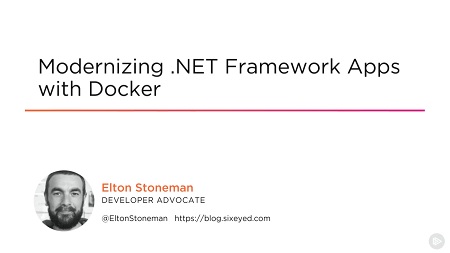
English | MP4 | AVC 1280×720 | AAC 44KHz 2ch | 3h 42m | 666 MB
Docker can help you bring your existing applications into the modern world. This course teaches you how to run full .NET applications in Windows containers, modernize the architecture, and deploy to the cloud.
Docker isn’t just for greenfield microservices applications, you can take full .NET Framework applications and run them in containers with no code changes. That’s a great starting point for modernizing the architecture and moving to the cloud. In this course, Modernizing .NET Framework Apps with Docker, you’ll learn how to efficiently run .NET applications and create a more modern architecture utilizing Docker. First, you’ll discover how to package and run .NET apps in Docker containers on Windows. Then, you’ll explore how to evolve the application architecture by breaking features out into separate containers. Finally, you’ll delve into taking your modernized app to production on Azure. By the end of the course, you’ll understand how Docker works on Windows and what Docker can do for your existing .NET landscape. Software required: Docker.
Table of Contents
01 – Course Overview
02 – Introducing App Modernization with Docker on Windows
03 – Principles of Modernizing .NET Framework Apps
04 – How the Demo WebForms App Will Evolve in the Course
05 – Packaging .NET Apps in Docker Using MSIs
06 – Running ASP.NET Web Apps in Windows Containers
07 – Limitations Using MSIs to Build Docker Images
08 – Compiling .NET Apps from Source in Docker Containers
09 – Packaging .NET Apps in Docker with Multi-stage Builds
10 – Module Summary
11 – Introducing SQL Server Containers on Windows
12 – Packaging Database Schemas into Docker Images
13 – Building SQL Server Data Tools Projects in Containers
14 – Packaging SQL Server Dacpacs with Multi-stage Builds
15 – Configuring Containers to Deploy New or Updated Databases
16 – Running a Disposable Database in a Docker Container
17 – Understanding Docker Volumes and Image Layers
18 – Running a Persistent Database in a Docker Container
19 – Automating Database Schema Updates with SqlPackage
20 – Updating the Schema in a Database Container
21 – Module Summary
22 – Scaling Performance with Aysnchronous Messaging
23 – Running a Message Queue in a Docker Container
24 – Connecting the Web Application and Database Containers
25 – Replacing Synchronous SQL Server Access with Event Publishing
26 – Publishing Event Messages from the Web Application
27 – Handling Event Messages in a Console Application
28 – Understanding Asynchronous Messaging with Containers
29 – Building the Web App and Message Handler as Docker Images
30 – Running the Solution in Containers with the NATS Message Queue
31 – Module Summary
32 – Adding Self-service Analytics to the Solution
33 – Running Elasticsearch and Kibana in Docker Containers
34 – Packaging Elasticsearch as a Windows Docker Image
35 – Packaging Kibana as a Windows Docker Image
36 – Populating Elasticsearch with a .NET Message Handler
37 – Building the Document Index Message Handler
38 – Packaging the Index Message Handler as a Docker Image
39 – Running the Analytics Components in Containers
40 – End-to-end Testing with SpecFlow in a Container
41 – Module Summary
42 – Adding Self-service Content to the Solution
43 – Running Umbraco and Nginx in Docker Containers
44 – Packaging Umbraco as a Windows Docker Image
45 – Setting up a New Homepage in Umbraco
46 – Deploying and Configuring Umbraco in Docker
47 – Updating the Web Application Deployment
48 – Running Nginx as a Reverse Proxy for Umbraco and the Web App
49 – Deploying and Configuring Nginx in Docker
50 – Adding Proxy Features – Compression and Caching
51 – Module Summary
52 – Managing and Monitoring Applications in Containers
53 – Defining and Managing Solutions with Docker Compose
54 – Running the Webinar Application with Docker Compose
55 – Building the Webinar Application with Docker Compose
56 – Monitoring in Multi-container Solutions
57 – Adding Prometheus Metrics to the Webinar Containers
58 – Running Prometheus in a Windows Container
59 – Monitoring with Prometheus and Grafana
60 – Adding a Grafana Dashboard to the Solution
61 – Module Summary
62 – Production Containers with Docker Swarm
63 – High Availability, Security and Management with Swarm
64 – Creating a Docker Swarm from Azure Marketplace
65 – Deploying the Webinar Application to the Swarm
66 – Production Considerations for Dockerfiles and Compose Files
67 – Integrating Docker Secrets with .NET Applications
68 – Integrating Docker Containers with SQL Azure
69 – Using Docker Secrets for .NET App Configuration
70 – Managing Production Docker Applications
71 – Course Summary
Resolve the captcha to access the links!